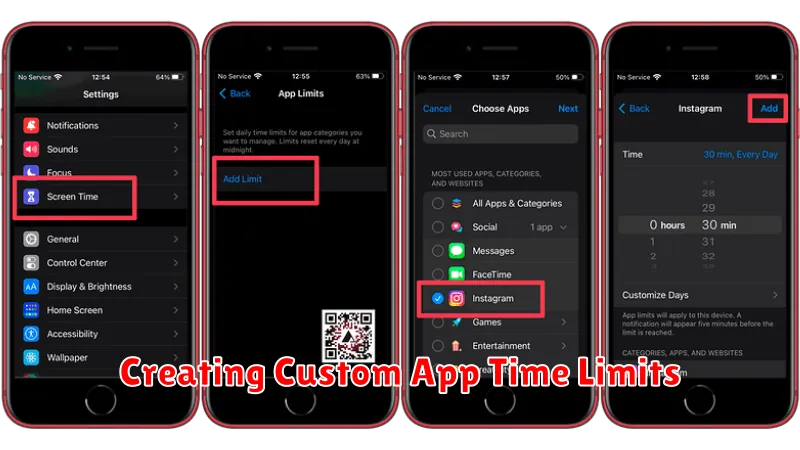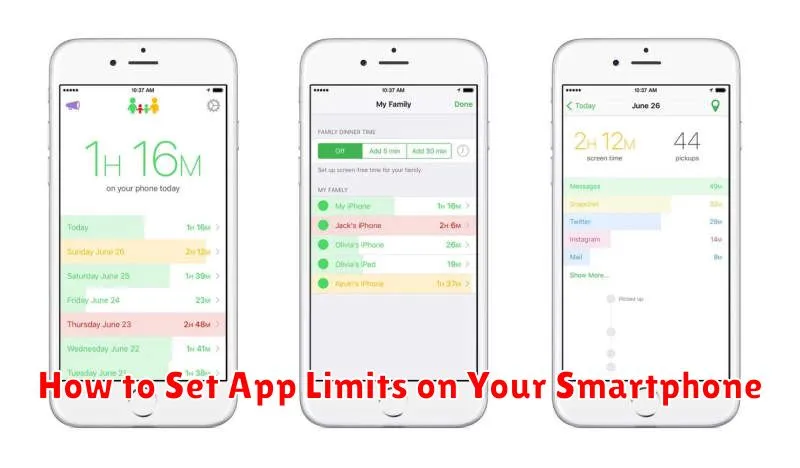Do you find yourself spending excessive time on social media, games, or other apps? Do you feel like you’re constantly picking up your phone, even when you don’t need to? If so, you’re not alone. Many people struggle with managing their smartphone usage. Setting app limits can be a powerful tool to help you regain control of your time, boost productivity, and improve your overall well-being. This article will provide a comprehensive guide on how to set app limits on your smartphone, covering various operating systems and providing practical tips for sticking to your goals.
Learning how to set app limits is crucial in today’s digitally driven world. Excessive screen time can lead to a range of negative consequences, including decreased productivity, sleep disturbances, and even anxiety. By implementing app timers and usage limits, you can cultivate a healthier relationship with your smartphone and prioritize real-world interactions and activities. Whether you’re using an iPhone, Android device, or another operating system, this article will empower you to take control of your app usage and achieve a more balanced digital lifestyle.
Why Limit App Usage?
In today’s digital age, excessive app usage can significantly impact our lives. Setting app limits allows you to regain control over your time and attention. It’s easy to get caught in endless scrolling or notifications, leading to decreased productivity and a sense of being overwhelmed.
By consciously limiting your time on certain apps, you can improve your focus, enhance productivity, and prioritize real-life interactions and activities. It also helps establish a healthier relationship with technology and promotes a more balanced lifestyle.
Reclaiming your time is a key benefit. Think about how much time you spend passively scrolling. Those minutes add up quickly. With app limits, you can dedicate that time to more fulfilling pursuits.
Tools on Android and iOS for Control
Both Android and iOS offer built-in features to manage app usage. Digital Wellbeing on Android and Screen Time on iOS provide detailed usage statistics and allow you to set daily time limits for individual apps.
These tools let you schedule downtime, receive usage alerts, and even completely block access to certain apps during specific times. They are valuable resources for understanding your app usage patterns and taking control of your digital habits.
On Android, you can typically find Digital Wellbeing in your phone’s settings. Similarly, Screen Time is located in the settings app on iOS devices.
Creating Custom App Time Limits

Most smartphones offer built-in tools to manage app usage. These tools typically allow you to set custom time limits for individual apps.
The process usually involves navigating to your device’s settings, finding the digital wellbeing or screen time section, and selecting the app you wish to restrict. You can then specify a daily or weekly time allowance.
Once the allocated time is reached, the app will typically be blocked or paused, preventing further usage until the next time period begins. Some systems offer a grace period or the ability to temporarily override the limit.
Notifications to Stay Aware
While limiting app usage is crucial, staying informed is equally important. Configure notifications strategically to find a balance. Disable non-essential notifications that contribute to mindless phone usage. This includes social media updates, game alerts, and promotional content.
Focus on notifications that provide essential information or require timely action. Examples include calendar reminders, work emails, and messages from important contacts. By filtering notifications effectively, you can reduce distractions while staying updated on what truly matters.
Explore notification customization options within your device settings. Most smartphones allow you to categorize apps and customize their notification behavior. This offers granular control over the alerts you receive and minimizes interruptions.
Weekly Usage Reports
Most smartphones offer built-in tools to generate weekly usage reports. These reports provide valuable insights into your app usage patterns. They typically break down the time spent on individual apps, categorized by day or week. Reviewing these reports is crucial for understanding where your time is going.
Identifying Time-Consuming Apps is the primary benefit of these reports. By seeing a clear visualization of your usage, you can pinpoint which apps are consuming the most time, allowing you to make informed decisions about adjusting your habits.
Some operating systems also offer aggregated weekly reports showing total screen time across all apps, providing a broader overview of your phone usage. This holistic view can be useful for setting overall screen time goals.
Balancing Productivity and Downtime
Setting app limits isn’t just about reducing screen time; it’s about achieving a healthy balance between productivity and downtime. Intentionally managing your phone usage allows you to maximize your focused work hours while also ensuring you have adequate time for relaxation and recharging. This balance is crucial for maintaining overall well-being and preventing burnout.
By allocating specific time slots for work and leisure, and using app limits to enforce these boundaries, you can cultivate healthier habits and improve your overall quality of life. This approach helps you stay present in the moment, whether you are focusing on a task or enjoying your free time.

